SAKAGUCHI Masashi
“Tokusatsu (special effects) art directors” have made a great contribution to image culture as the head of the tokusatsu team’s art department, being responsible for creating various subjects for shooting, such as miniature sets, super weapons, and monsters featured in tokusatsu works. Compared to “tokusatsu directors” such as TSUBURAYA Eiji, the position of “tokusatsu art director” has attracted much less attention. In 2022, a large-scale exhibition shed light on the low-profile position. Titled “The art of Special Effects Production Designer Yasuyuki ‘TAIKO’ Inoue” (hereinafter “Yasuyuki Inoue Exhibition”), the exhibition was held at the Museum of Contemporary Art Tokyo, featuring INOUE Yasuyuki, a tokusatsu art director who supported the golden age of tokusatsu films produced by Toho Company, Ltd., in commemoration of the centennial of his birth. In this interview, MIIKE Toshio, supervisor of the exhibition and himself a tokusatsu art director, talked about the work and legacies of tokusatsu art directors and the uniqueness of INOUE Yasuyuki among them.
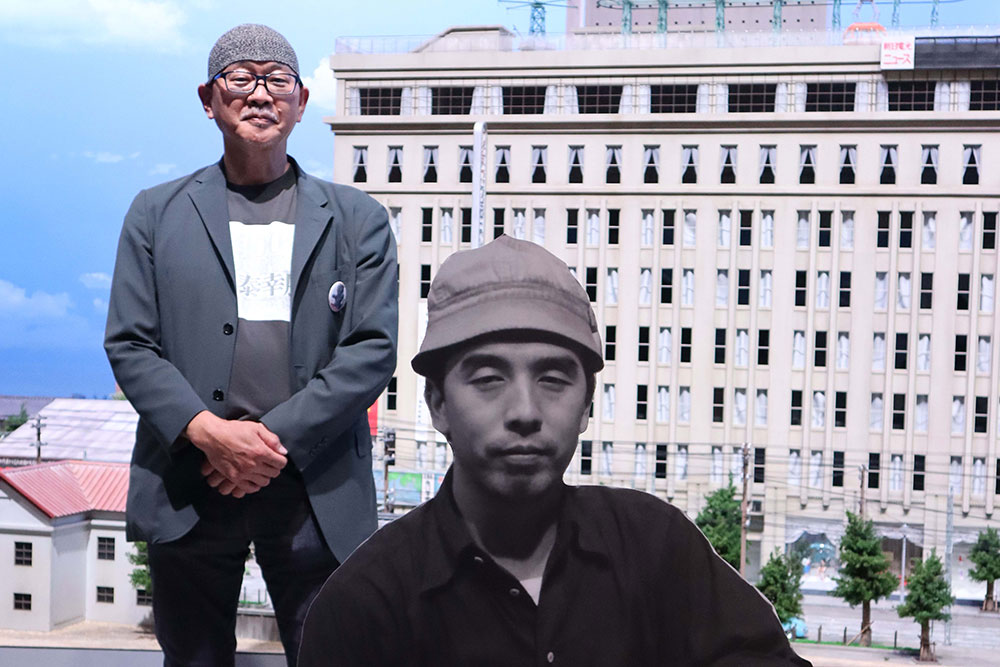
—This interview will focus on “tokusatsu art director.” First of all, talk about the role played by “tokusatsu art directors” in film production.
MIIKE Usually, each tokusatsu film has been made by two different teams: one is “honpen” team for shooting human characters and the other is “tokusatsu” team for shooting monsters and miniature objects. Before talking about “tokusatsu” as a classified genre, let me explain what is meant by the term “art” (“bijutsu” in Japanese) in film production. “Art” department staff visualize the situations written in the script. Some films are shot mainly on location with real scenes, while some others, such as science fiction and fantasy, involve an unreal world. In any film, art design is essential to express the written information in the script as subjects for shooting. Even when shooting on location, we often modify existing conditions by, for example, making new buildings and fields. In Nobo no Shiro (The Floating Castle) (2012), a fort-like castle was built almost at the level of a large-scale civil engineering project, including digging a moat, planting greenery, and building an embankment. Overseas, for example, in The Lord of the Rings (2001), a hobbit village was created in a similar manner. The art staff sometimes create a “world” on such a grand scale. The head of the art staff is the “art director.”
The work of the “tokusatsu art director” is the same as that of the “art director” for ordinary films in that they “visualize what is written in the script.” However, when shooting films of the so-called tokusatsu genre, especially monster films, we usually do not use existing conditions on location sites as they are, and instead, mainly use miniature objects. It is true that tokusatsu films use a method called “shakkei” (lit. borrowed scenery), in which a monster or tank is placed in the foreground, and the actual scenery in the background is used as a background scene, but in principle, tokusatsu staff shoot subjects on a reduced scale, that is, prepared miniature objects, which include not only man-made structures such as buildings and houses, but also natural objects such as mountains, the sea, rivers, and the sky. In other words, for tokusatsu, everything that is to be captured by the camera need to be created from scratch. It is a major difference between the art for honpen shooting and the art for tokusatsu shooting. Consequently, the tokusatsu art director needs to do much extra work. The level of their management skills in controlling the quality of required miniature objects, their budget and production schedule much affects the quality level of sets for shooting.
—Without subjects for shooting, filming would not be possible. Schedule control is also indispensable. In this respect, tokusatsu art directors have an influence on the entire shooting, not alone on the art department.
MIIKE It is true, in a way. In terms of scheduling, it starts with securing a studio by the chief assistant director and the production department. Then, the chief assistant director starts specific discussions with the tokusatsu art director about the art department’s work schedule based on the shooting schedule they have established by counting backward from the scheduled release date. At this time, the tokusatsu art director may make a request to shoot any set that needs many materials and much time to make later than other sets, but the request is not always met. In this sense, the art department does not always decide the schedule, but the tokusatsu art director is always consulted when practical matters are planned and decided. Director ASADA Eiichi says that when he was an assistant director, INOUE rarely asked him during their meetings to change the sequence of the shooting schedule. His art department managed to meet the requested dates for shooting. It means they worked hard to meet the deadline, even by working overnight.
—The “Yasuyuki Inoue Exhibition” uses the job title “tokusatsu art director.” It is also called “tokusatsu designer.”
MIIKE Originally, the title “art director” was not used in film studios. “Designer” was commonly used. Using “shooting director” and “art director” as job titles began many years after I and other tokusatsu art directors of my generation entered the industry. Their work is the same, whether they are called “art director” or “designer.” But the term “designer” is too vague to adequately explain the nature of the job as there are many different types of designers, such as fashion designers and industrial designers. I think “art director of films” clearly explains the nuances of the work.
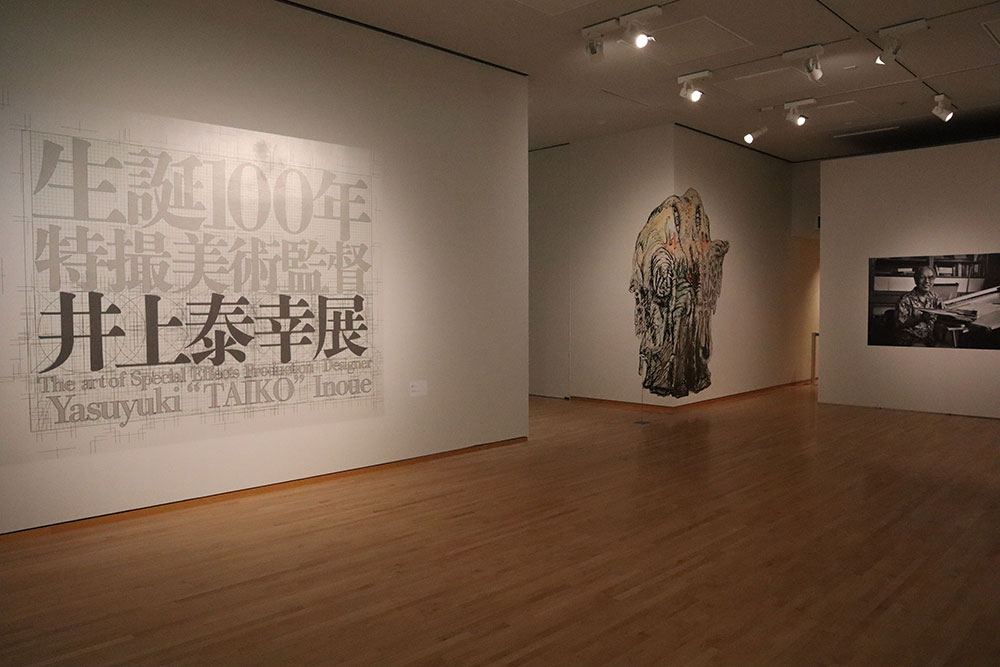
—When preparing sets required for shooting, are they conceived and planned based on descriptions in the script?
MIIKE Yes. As for the script, the producer first makes its plan and then asks the scriptwriter to work on it. The directors in charge are often selected at this stage or when the first script is finished. Four people–the producer, scriptwriter, director of the part not using tokusatsu, and director of the part using tokusatsu–then work together to develop the world of the work.
—So, they share general visual images of the film.
MIIKE It depends on the film and the production company. As for Toho, for example, MORI Iwao, the head of the production department in the 1950s, first used a method called “pictorial sketching”1 based on a U.S. method, in which a world of a film is created by arranging specific drawings. I have not heard of other companies placing emphasis on drawings in that manner.
—WATANABE Akira, the tokusatsu art director of Godzilla (1954) and other films, was involved in their pictorial sketching.
MIIKE WATANABE was extremely good at drawing pictures. He was a reliable team member for director TSUBURAYA in bringing images to life quickly and accurately. Art directors need to be able to draw pictures, but it depends whether they are good or bad (laughs).
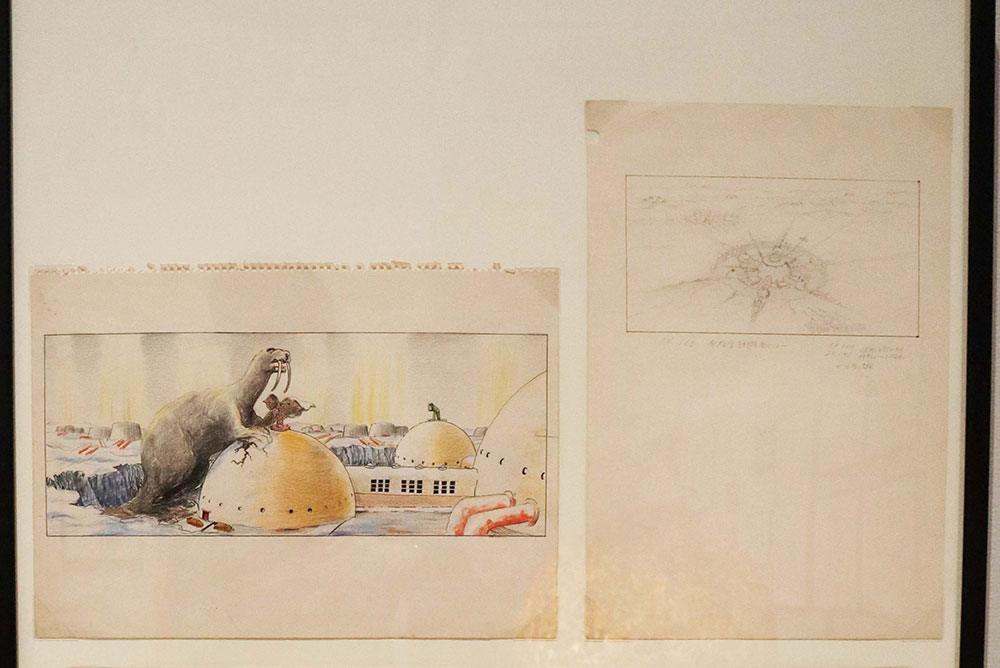
—Pictorial sketching is the forerunner of concept arts and storyboards.
MIIKE Storyboards by INOUE are different from storyboards in the general sense. Concept arts and storyboards are basically made under the instructions of directors. INOUE created storyboards on his own initiative, not asked by directors. By doing storyboarding, he was able to have the concrete image of a set before making it. When exhibiting storyboards by INOUE at the “Yasuyuki Inoue Exhibition,” we named them “INOUE method storyboards.” We did so as a desperate resort to distinguish his storyboards from ordinary storyboards as people may take them as being drawn for shooting if they are exhibited just as “storyboards” (laughs).
—I now understand the background reason for the naming. About storyboards, it is said that director TSUBURAYA used storyboards by INOUE when shooting Nihonkai Daikaisen (Battle of the Japan Sea) (1969).
MIIKE That is right, but storyboards by TSUBURAYA for Nihonkai Daikaisen (Battle of the Japan Sea) have also been found. It is not certain whether storyboards by INOUE were copied to use, or there were storyboards drawn separately but he decided to use INOUE’s. There had been built a deep relationship of trust between TSUBURAYA and INOUE by the time. TSUBURAYA did not feel that the art department was interfering with his way of directing tokusatsu shooting. There is an episode symbolizing their relationship. During a photo session commemorating Nihonkai Daikaisen (Battle of the Japan Sea), TSUBURAYA made a seat available for INOUE, who would be arriving late. When WATANABE was still with Toho, TSUBURAYA and INOUE had frequently clashed due to differences in their ways of doing things, but all episodes I have heard about their clashes tell that they resulted in increasing INOUE’s reputation. After WATANABE departed, INOUE became the head of the art department. Around the time, it seems a firm relationship of trust was built between them. TSUBURAYA left all about preparing sets to INOUE. TSUBURAYA did shooting relying on meticulous sets and collapsing structures designed by INOUE. I have no doubt that INOUE played the role of a directing assistant while belonging to the art department.
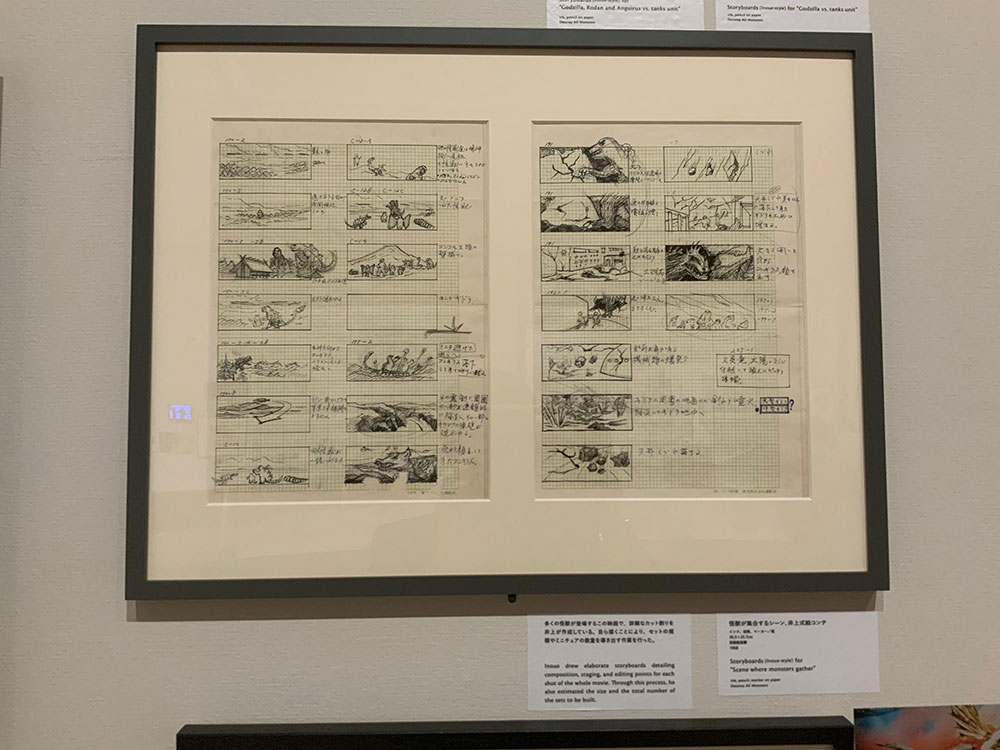
—INOUE also decided camera positions at the stage of designing sets. Is planning camera positions a fundamental part of the tokusatsu art director’s work?
MIIKE Yes. The same is true for the art director for the honpen part not using tokusatsu. You cannot do the art department’s work unless you know about the lens. For tokusatsu shooting, setting camera positions is even more important as it affects perspective for expressing depth of each set. Of course, it is the cinematographer who decides the lens to use, so we don’t discuss in advance very much in detail, such as using a lens with what-millimeter focal length and how much to zoom out.
—Then, you may smile secretly when the camera position is exactly as you have expected.
MIIKE You are quite right. In contrast, if the camera enters a different position, I would think, “Oh, you don’t understand” (laughs). About the main position, the camera is guided almost to the position designated by the art department as the shooting staff share images to be shot from the position through the storyboards. Then, the set for shooting is always reworked for each cut based on how it looks like from the final camera position.
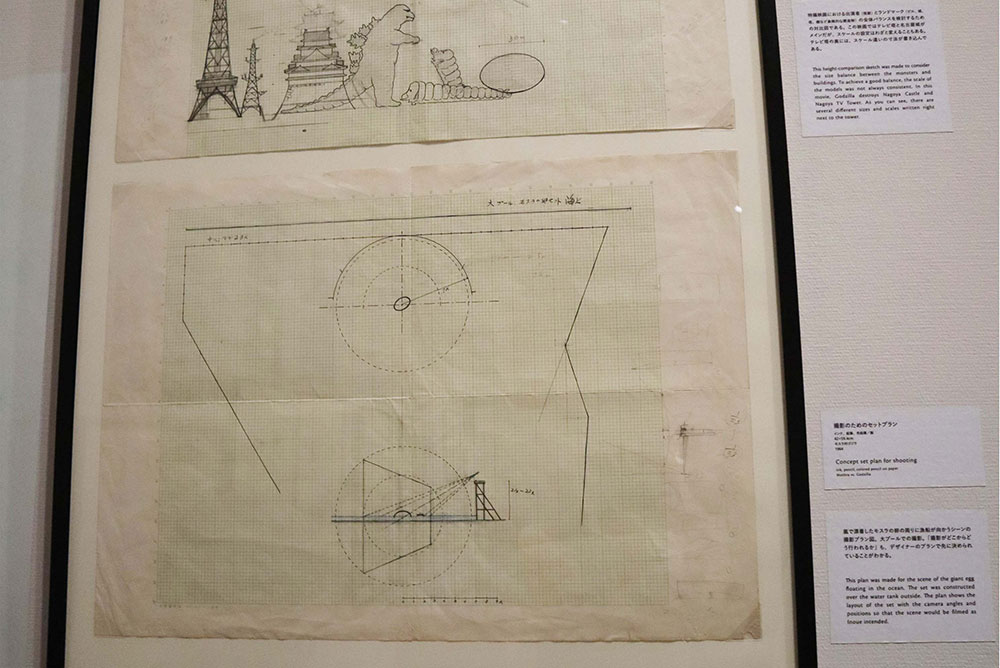
—When making sets, you have to consider coordinating with various other departments, such as the department in charge of the wire effects technicians, I suppose. How do you make discussions with them?
MIIKE When it is necessary to prepare in advance for scenes of destroying something or a monster appearing from the ground, for example, INOUE first discussed with the director and then conveyed the information and instructions in detail with the practical effects staff and the special effects staff. In INOUE’s era, the art director was given much authority. The company’s organizational chart shows no difference in rank among the departments specializing in art, carpentry, painting, sculptures, plaster, physical effects tham, wire effects technicians, electricians, and machining. In reality, the art department was the de facto core and there was a hierarchy where all the departments were to work under the tokusatsu art director. In contrast, in our era, the status of the art department and the other departments are almost equal.
—I see. INOUE supervised the entire production of subjects for shooting.
MIIKE INOUE also did budget management for making sets, including personnel and material costs, and staff schedule’s management, all by himself. I don’t think other tokusatsu art directors do that much.
When OSAWA Tetsuzo was the tokusatsu art director for the Heisei Godzilla series [the Heisei Godzilla series between Godzilla vs. Biollante (1989) – Godzilla vs. Destoroyah (1995)], budget management was not done by him, but by TOHO EIZO BIJUTSU Co., Ltd. in charge of preparing sets. As OSAWA was not a Toho employee, Toho could not give full authority to OSAWA. Since the company calculated costs based on set plans proposed by OSAWA, it thought it would need someone who asks OSAWA to cut the cost when they exceed the budget.
—How was it when you were the tokusatsu art director?
MIIKE When I was in charge, the budget was similarly managed by TOHO EIZO BIJUTSU.
—Is there any difference in finished objects depending on whether a single person in charge, like INOUE, manages all or someone else manages budgets?
MIIKE When the company side manages budgets, it inevitably focuses on making profit, so it is not always flexible. On the other hand, it is natural that in order to secure healthy company operation, it is impossible to allow to make a loss in exchange for improving a work. So, it depends on the positions of persons in charge. In the case of INOUE, I think that he was not satisfied unless he took care of everything himself, without leaving anything to others, to achieve the quality as he wanted. He even decided the number of palm trees needed to depict an airfield in the southern front in a war film.
—About INOUE’s budget management, there is an “INOUE method set design,” which contains concept arts, sketches, budget list, and storyboards by text, among others, in one document.
MIIKE He developed the method to efficiently orchestrate all about each set, I think. Usually, concept arts, plan views, and budget lists are made separately. In this system, each time you need any of them, you need to get it each. With INOUE’s method, you can see at a glance the scene to be depicted by the set, its scale, and required work and budget. It is also easier to make adjustments, for example, based on a decision that “This budget allocated for this set is too much, so I should use the surplus for another set.”
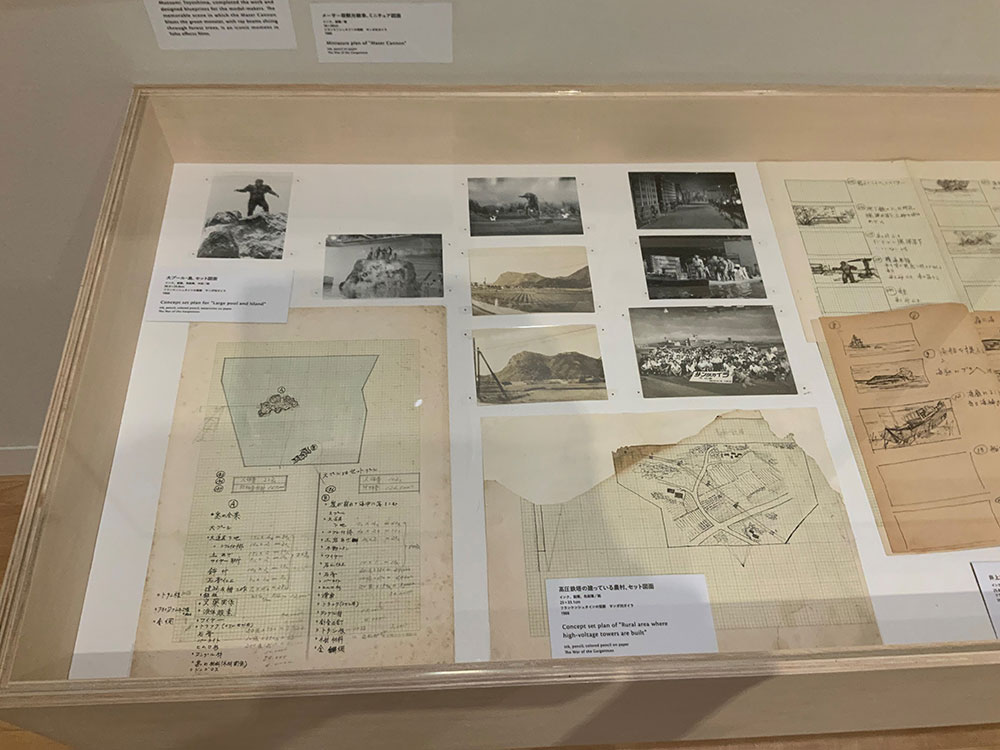
—Did he show set concept design documents to the directors and others?
MIIKE No, they were really confidential documents. I am sure that INOUE did not intend to show them to anyone when making them. He did not show them to the directors. He did not show them to the art staff and the carpentry department staff. He probably gave the staff the concept arts and sketches contained in each document, but did not show the entire document disclosing everything. He probably showed only the budget part to Toho Eizo Bijutsu executives and the producer. They were INOUE’s strategic drawings that he made simultaneously with the storyboards, or after the storyboarding process.
—I wanted to know how the know-how of the “INOUE method set design” influenced tokusatsu art directors following him. I now understand that no one has ever seen them before.
MIIKE You are right. INOUE did not teach the method to anyone. I have never seen anyone, not only at Toho but also at other companies, using such a method.
—Now that the “Yasuyuki Inoue Exhibition” has revealed its whole picture, it may have an influence on today’s tokusatsu staff.
MIIKE I’m not sure. The method may have been suited only for the era when INOUE was active. In those days, tokusatsu films were being made one after another. Many sets and miniature objects were needed, such as more than 10 sets for a single film. Nowadays, it is possible to create one high-quality set including miniature objects to use them as the centerpiece. The number of film productions is smaller, to begin with.
Although controlling various these things is an important role played by the art director of films, it is surprising that the role is little known to the public. To be an art director of films, having the ability to draw is not enough. In addition to planning in-house staff’s work schedule, they need to grasp all of costs and delivery dates related to outsourcing the production of sheet metal models to, for example, Toita Industries Inc.2 and Gunji Models.3
—How do tokusatsu art directors select such contractors?
MIIKE It depends on the experience we have accumulated through each film project. The more you do it, the better you can estimate the quality level of a product to be delivered to you and the number of days required to make it.
—When you became a tokusatsu art director, did you utilize your experience you had gained from the time when you were an assistant?
MIIKE Yes, I did. When I was in charge of drawing, I was also involved in placing orders and doing checks during the production process, which I did as a part of the work of an assistant. As budget lists are top-secret documents, they were not shown to assistants like me very often. But I got part of them and obtained some knowledge. When I just became a tokusatsu art director, I referred to figures in budget lists I had got in the past. Later, I obtained and accumulated more data by doing it myself.
—I see, the more experience you accumulate, the more accurately you can estimate.
MIIKE My figures are only based on my assumption, so I always give drawings to the contractor involved each time and receive an official estimate. Each contractor has its own circumstances, such as the need to increase estimates for such reasons as losing a craftsman in charge, increased material cost, and payment of the initial cost of a new machine, and so on. I sometimes suggest ideas about reducing their estimates. For example, when I worked on the Heisei Gamera, the budget was so tight that a train was made to have a realistic appearance only in the direction to be shot by the camera. When seeing the train from its back, you will see there is nothing built there (laughs).
—It was possible to do so as the camera position was decided in advance.
MIIKE Director KANEKO Shusuke and special effects director HIGUCHI Shinji in charge were both good at drawing. They shared storyboards and agreed on them in advance. Our art department was grateful that the scenes the directors want to shoot were provided on the storyboards. Even if changes or additions would be needed later, the basic policy remains the same, so we can make preparations without waste. If someone else was assigned to draw storyboards, things would have been changed one after another.
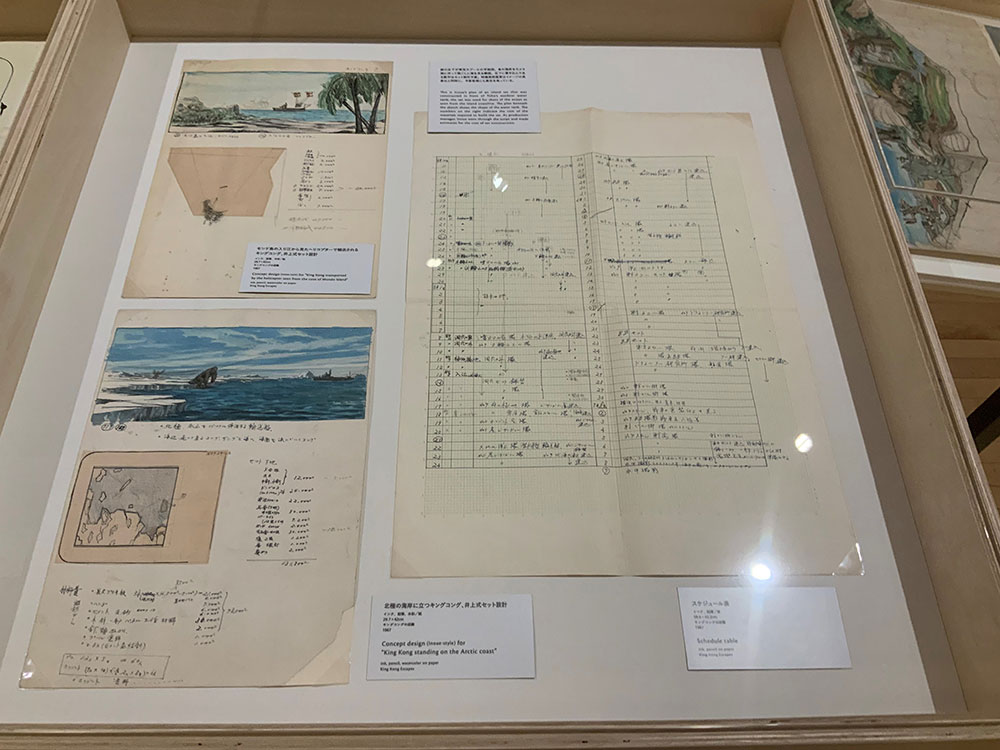
—INOUE also designed several monsters.
MIIKE The art department needs to design everything that is to be shot, so designing monsters is a part of its work. The tradition started when WATANABE Akira was in charge. INOUE took it over as the art director.
—Is it the same for TV works such as ULTRA Q (1966)?
MIIKE That’s right. NARITA Tohl was in charge of all of set designing and monster designing as art director when he was with Tsuburaya Productions. His successor, IKEYA Noriyoshi, followed in his footsteps, taking charge of all matters of designing. In 1980s and later, monster designing and mechanical designing were shifted to independent people. Directors NAKANO Teruyoshi and KAWAKITA Koichi outsourced drawings to such independent designers. Even in the early days of Toho’s special effects films, famous freelance artists were asked to do the work, such as KOMATSUZAKI Shigeru for The Mysterians (1957). But in principle, the art department designed anything.
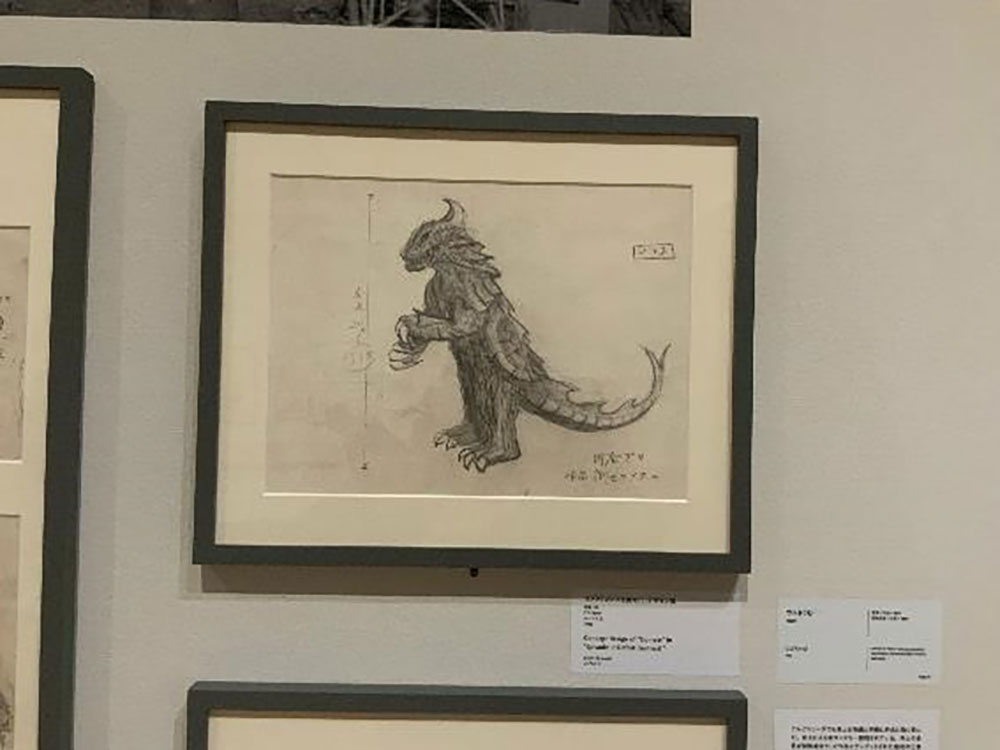

—This exhibition also displays concept designs of monsters Sanda and Gaira by NARITA Tohl. I was surprised as they were not shown even in the exhibition “Tohl Narita: Bijutsu/Tokusatsu/Kaiju” (TOHL NARITA: Art/Special Effects/Monsters).4
MIIKE The War of the Gargantuas (1966) was the first tokusatsu film I experienced in my life. I exhibited some original sketches as I wanted the visitors to know the relationship between INOUE and NARITA. INOUE became in charge of ULTRA Q when the TV program shifted to featuring monsters and he recommended NARITA be included in the staff of ULTRA Q. But NARITA’s concept designs of Sanda and Gaira were not accepted as they were. They were retouched by KOMURA Hiroshi, INOUE’s assistant. As to why NARITA came to make concept designs of Sanda and Gaira, I guess director TSUBURAYA Eiji asked NARITA to draw again, for his next film, when going back and forth between Toho and Toho Art Center (later renamed to Toho Built), where Ultraman (1966–1967) was being produced. As INOUE basically did not like to entrust doing things to other people, there is no way he would approve of sketches done by someone who was not a member of the staff. Actually, NARITA was not an outsider for INOUE. NARITA had worked on Godzilla, Godzilla Raids Again (1955), and Rodan (1956) as a member of the plaster department and then helped the background picture department staff. This means, when NARITA was with Toho, he worked under INOUE. Even though he was not a staff member, he worked close to INOUE. INOUE seemed to know that NARITA had established himself as an art director when he was working for Toei Company, Ltd. after leaving Toho. INOUE even wrote in a diary that he somehow recognized NARITA as a rival.
—INOUE even named NARITA to work on ULTRA Q as his successor, saying, “Bring in NARITA from Toei.”
MIIKE There is no way he would have recommended someone he did not approve of.
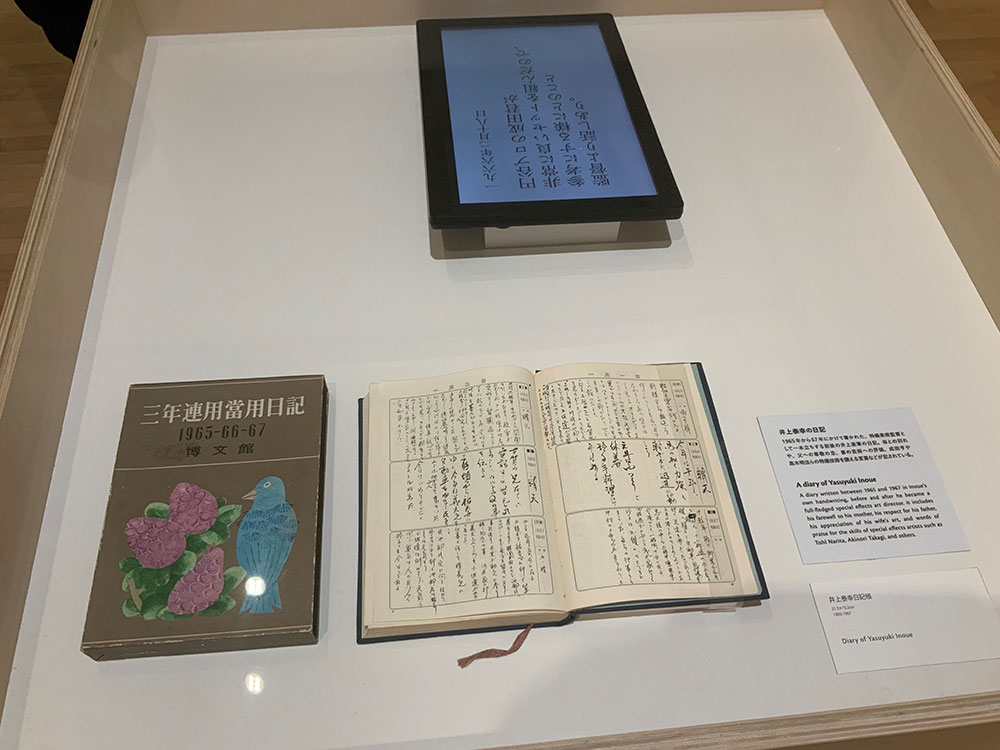
notes
information
The art of Special Effects Production Designer Yasuyuki “TAIKO” Inoue
Dates: March 19 (Sat.)–June 19 (Sun.), 2022
Closed: Mondays (open on March 21), March 22
Venue: Museum of Contemporary Art Tokyo, B2F
Admission: 1,700 yen for adults; 1,200 yen for college/university/vocational school students and people at the age of 65 and older; 600 yen for junior high and high school students; free for elementary school students and younger
https://www.mot-art-museum.jp/en/exhibitions/yasuyuki-inoue/
*URL links were confirmed on June 2, 2022.